Hearty Hydrangea | How to Grow Bountiful Blooms
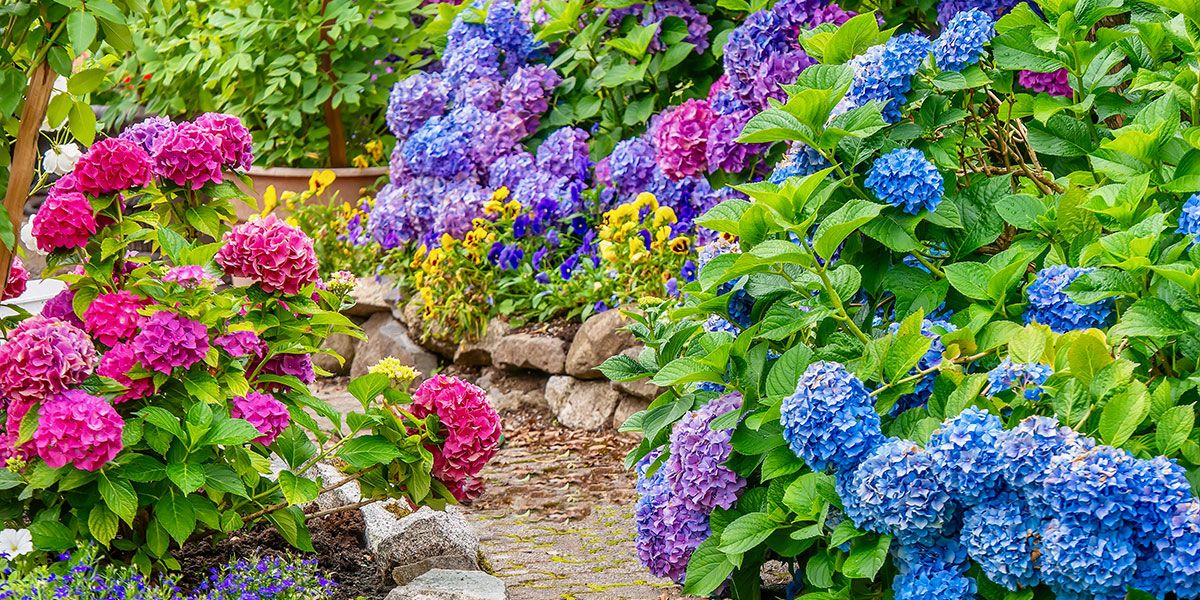
The striking beauty of a flowering hydrangea swaying in the summer breeze can stop even the most casual of gardeners in their tracks. Their appearance has captivated people for centuries, and they remain popular in many cultures. From Japan where hydrangeas were first cultivated, to the gardens of Normandy, France and the vibrant blue shores of the Azores, these beauties are loved and celebrated worldwide. There are two hydrangeas that are native to North America: the oakleaf and the smooth hydrangea. Notably here in Virginia, three presidents—Washington, Jefferson and Madison—chose to cultivate hydrangeas on the grounds of their respective homes. There’s no question why: They naturally elevate the feel of any yard when paired with other native favorites like azaleas, ferns, hollies and sweet potato vine. Traveling to historical places and faraway islands is not necessary when it comes to appreciating all that hydrangeas have to offer. Correct placement, proper watering and minimal pruning can produce many different shades of pink, purple, blue and white that can dot the landscape of our own gardens here at home.
A variety for every garden
There are four main types of hydrangea: big leaf, smooth, oak leaf and panicle, all with unique features and variations that will grow well in our area, and will complement any landscape design.
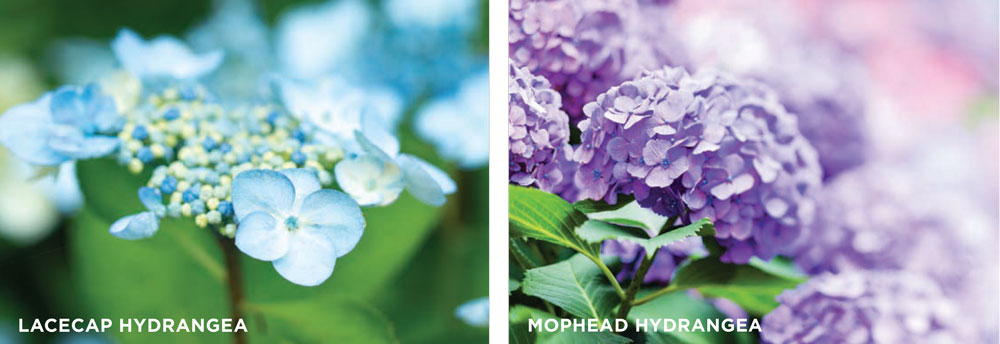
Big leaf hydrangea
Hydrangea macrophylla, or big leaf hydrangea, are divided into three categories: the mophead, the lacecap and the mountain hydrangea. Mopheads are the most popular of the big leaf hydrangea because of their large round flower heads, their vibrant pink, blue and purple colors and their thick, crisp, heart-shaped leaves. Lacecap blooms have a unique appearance with a group of small buds in the center, surrounded by smaller open flowers around the outside. Mopheads and lacecaps are similar in that they bloom in early summer, and will grow into a bush that is up to six feet tall and eight feet wide. They do well in areas with morning sun and afternoon shade, with that shade being especially important in areas with hotter climates. Big leaf hydrangeas tend to lose a lot of water because of their large leaves, so watering one to three times per week during the summer is essential. But be careful of soggy soil; all four types of hydrangea do better in areas with good soil drainage. Popular varieties of mopheads include Endless Summer and Let’s Dance Moonlight. Let’s Dance Starlight is a popular kind of lacecap. All of these varieties have become a gardeners’ dream because of their ability to bloom all summer and into the fall.
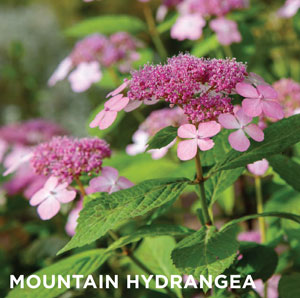 Mountain hydrangea were previously grouped with lacecaps because of the similarity of the appearance of the flowers they produce, but now get a distinction all their own. They are perfect if you need something smaller in the garden, growing to only about four feet tall and wide. Mountain hydrangea tend to be hardier than mopheads and lacecaps, lasting through harsher climate conditions. They bloom well into autumn and popular varieties include Tiny Tuff Stuff and Tuff Stuff Ah Ha.
Mountain hydrangea were previously grouped with lacecaps because of the similarity of the appearance of the flowers they produce, but now get a distinction all their own. They are perfect if you need something smaller in the garden, growing to only about four feet tall and wide. Mountain hydrangea tend to be hardier than mopheads and lacecaps, lasting through harsher climate conditions. They bloom well into autumn and popular varieties include Tiny Tuff Stuff and Tuff Stuff Ah Ha.
All three of the big leaf hydrangea change color depending on the acidity of their soil. A more acidic soil will produce deep blue and purple flowers and a more alkaline soil, or less acidic soil, will produce pink flowers. More than any other hydrangea, the big leafs will need an all-purpose fertilizer that contains equal parts nitrogen, phosphorus and potassium, starting in early spring and continuing through July, especially to encourage reblooming. All-purpose fertilizers come in either liquid form, granules or spikes; all are equally effective when feeding hydrangeas.
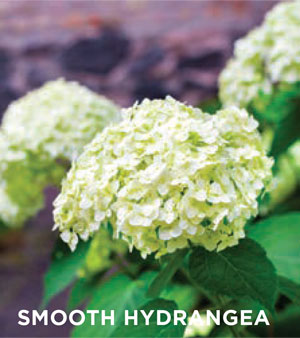 Smooth hydrangea
Smooth hydrangea
Hydrangea arborescens, also known as wild hydrangea or smooth hydrangea, are native to North America, are very easy to grow and maintain, and are known for their tolerance to cold. Formerly a large hedge-like plant, scientists have bred newer, smaller varieties. Their leaves are heart shaped like the mopheads and boast large balls of white flowers that transition to green in the fall. There are smooth hydrangeas that come in shades of pink, purple and ruby red; however their color is not dependent on the acidity of the soil. Four hours of morning sun is recommended for smooth hydrangea and they require only one application of fertilizer in the spring. Beware of pesky deer; they love smooth hydrangea and will only be deterred by netting or deer repellant that is reapplied throughout the season. Varieties of smooth hydrangea include the ever-popular Annabelle and newer and sturdier Incrediball.
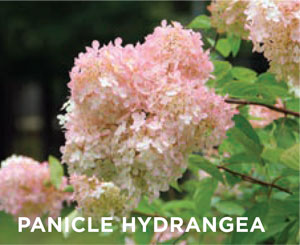 Panicle hydrangea
Panicle hydrangea
Hydrangea paniculata, or the panicle hydrangea, is easily identified by its cone-shaped flower heads and smaller, thin leaves. This sun-loving hydrangea is the only variety that can be shaped into a tree because of its central stem that turns into a strong and supportive trunk. They can be quite large, reaching up to ten feet in height, and are cold and heat tolerant. Panicle hydrangea are easy to grow and aren’t particularly picky when it comes to weather, soil or nutrients. If they get enough sun—six hours a day—and have welldrained soil, they will thrive. The flowers of these plants start out white and change to pink, red or burgundy regardless of soil acidity. The exception to this lies in a few notable varieties, Limelight and Little Lime. Their flowers start out green and change to pink over time.
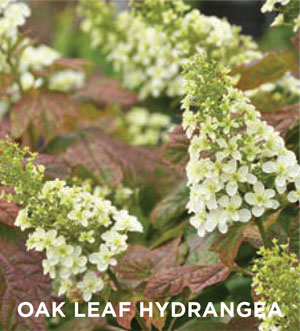 Oak leaf hydrangea
Oak leaf hydrangea
Hydrangea quercifolia, or the oak leaf hydrangea, gets its name from the shape of its leaves. It is the only hydrangea that can tolerate sun and heavier amounts shade, and blooms in late summer to early fall. It is unique in that the foliage also changes color as fall approaches, displaying warm orange, red and mahogany tones that last well into wintertime. The oak leaf hydrangea is also beautiful in springtime and blooms best in a hot and dry summer. Fertilizer is not a necessity for growth and they require minimal effort. Flowers on most oak leaf hydrangeas start out white and change to green or various shades of pink. Wellknown varieties include Snow Queen, Pee Wee and Ruby Slippers. From spring to summer, into fall and winter, gardeners love the long-lasting beauty and versatility of this plant.
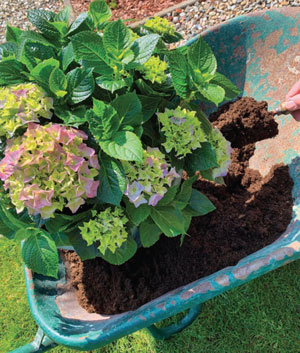 General care and planting
General care and planting
There are a few general tips that you can follow to keep your hydrangea plants happy and healthy. Hydrangeas should be planted in a sheltered area that offers morning sun and light afternoon shade, either on the north or south side of your home. The soil should be rich in organic matter and well drained in order to prevent root rot. Hydrangeas should not be planted directly under trees as this can cause competition for water and nutrients. Planting should occur in the milder temperatures of the spring and fall, and be sure to keep your pets away; hydrangeas are toxic to our furry friends.
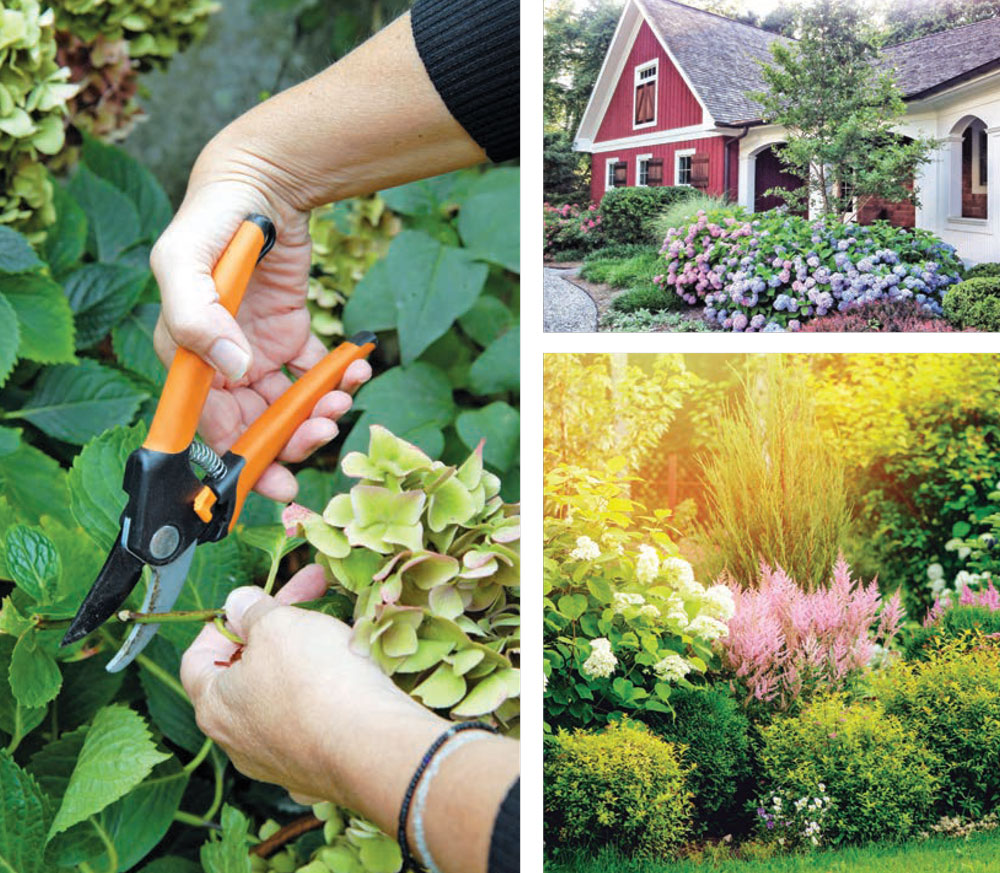
Precise pruning
The guidelines for pruning hydrangea are specific to the type of plant you have. It’s paramount to correctly identify your hydrangea plant before pruning, or you may risk losing all of your gorgeous flowers the next growing season. Hydrangea plants are either old-wood bloomers—flowers that bloom on the old wood, not the new growth—or new-wood bloomers, where flowers grow on new growth. Big leaf hydrangea (mophead, lacecap and mountain) and oak leaf hydrangea are all old-wood bloomers. These plants should be pruned after the flowers start to fade in late summer. A gentle pruning of the dead flower heads is all they need. Panicle and smooth hydrangea are new-wood bloomers and can be trimmed all the way down to the ground, which will promote the growth of much larger blooms. However, it is recommended to leave between 18 and 24 inches of the old plant so it can remain sturdy enough to support new growth and new blooms. Both panicle and smooth hydrangeas should be pruned in late winter to early spring, just before new growth begins. It’s a good idea to label your hydrangeas with garden stakes for the first few growing seasons to avoid pruning at the wrong time and losing your precious blooms.
Versatile and complementary
The large leaves and flowers of the many hydrangea varieties will pair well with a multitude of other plants in your garden. Ornamental grasses, ferns and hostas will coordinate well with the vibrant colors of the hydrangea plants, and will grow well in the shade of a larger bush. Plants that thrive in extreme conditions, mainly sun lovers and drought-tolerant plants, will not do well when paired with hydrangeas. Boxwoods planted in front of your hydrangea can protect them from the strong, cold winds of wintertime. Hydrangeas are also a perfect pick for containers, particularly if you choose a dwarf variety. Paired with sweet potato vine, begonias and impatiens, the different textures, shapes and colors are the perfect finishing touch to add flair to any porch or patio. ✦
big leaf hydrangea, flowering hydrangea, new-wood bloomers, oak leaf hydrangea, old-wood bloomers, panicle hydrangea, pruning, smooth hydrangea






